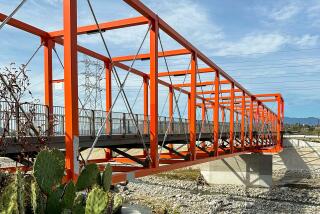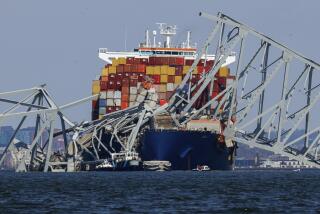Linking Lessons
- Share via
Not long after a new bridge was built across the gully that bisects the campus of UCLA’s acclaimed University Elementary School, youngsters in a combined kindergarten-first grade class were reading a fairy tale in which a bridge played a central role. So what if the campus bridge did not have a troll under it, as the one in the book did--it was an opportunity to link a classroom lesson with the “real world” right outside the door. Lisa Rosenthal, one of the students’ teachers, recounted the process of “building bridges,” both in a literal and an educational sense.
Three Billy Goats Gruff
The children of Room 11 (5- and 6-year-olds) became interested in bridges after another teacher, Annette Marks, read them a story of the “Three Billy Goats Gruff.” Because many bridges surround them at school, they had some prior knowledge of how a bridge is constructed and what its functions are.
A Conversation About Bridges
*
Teacher: Why was the bridge so important for the three billy goats?
Corey: Because they needed to go across it.
Gabrielle: Because there was lots for them to eat on the other side.
Teacher: What was the bridge’s function? Why was it there?
Keith: Because there was a mean troll underneath.
Dana: And water.
Teacher: So the bridge was like a pathway to get to the other side, where the food was. What are some other things underneath bridges?
Hailey: Lots of mud and plants.
Julia: Places you can’t walk.
Vivian: Trolls.
Teacher: What are some of the things that need to cross over bridges?
Leo: People and animals.
Anton: Big trucks.
Leo: Cars go over too, and they have to be really strong bridges.
Teacher: Which of the bridges at [the school] do you think is the strongest?
Dana: The north bridge.
Teacher: Why?
Dana: Because it’s the longest.
Leo: Because more people go over it.
The Investigation
*
The next day, clipboards in hand, the children worked in groups to investigate the four bridges at the school. Their mission was to sketch them and note their distinctions, such as: How long they are, of what materials they are made, what is surrounding them, what supports them and which one might support the most weight.
The children then discussed their sketches of the bridges. And after examining the similarities and differences, someone suggested building a bridge. There was an enthusiastic response.
Before the building could begin, many questions needed to be asked: What will the bridge be used for? How much weight will it need to support? What materials will have to be used? How should the materials be arranged to make the bridge strong?
The teachers talked about the importance and usefulness of scale models to test designs and then gave students various materials to try. Children first attempted to build with clay. They molded and sculpted and were able to create a variety of designs. As soon as they finished their masterpieces, however, gravity began to take its toll. The clay bridges started to collapse!
Looking for the source of the problem, Dana took a ruler and measured the taller pillar of her bridge and then the smaller one. She figured out that she had to add one inch of clay to the smaller pillar to make it even. She also learned that her pillars might hold more weight if they were stronger at the base than at the top.
Then the children used wood. With hammer, nails and sandpaper, each budding carpenter came up with a unique bridge design.
After discussing which materials could be presented next, the teachers decided to let the children choose. Breaking up into small groups, the youngsters decided which materials from the classroom would be suitable for bridge building. From blocks to checkers, each group came up with a different medium.
Next, Brian Hurd, an industrial arts teacher and the father of Ian, one of the students, came to speak to the class about shapes used in construction, such as triangles and arches. He spoke about railroad trestle bridges, which use a series of triangles to give them strength. Brian pointed out that the school’s north bridge is built with a similar design. The students decided they wanted to make a model of a railroad trestle bridge.
On his next visit, Hurd discussed the need for a plan or blueprint. Before drawing a plan, the children talked about their design and materials. Their model, they decided, would be constructed of Popsicle sticks and glue.
After building one railroad bridge, the children decided to build several more. Each student built individual spans, arranging the Popsicle sticks along the plan or pattern in triangles, and gluing the joints. After they were dry, the spans were connected to form trestles.
Next, Hurd discussed the importance of testing in construction--that structures must be inspected and/or tested to make sure they are safe.
After the bridges were complete, each was weighed. Julia recorded the numbers--the bridges ranged from 6 to 8 ounces.
They were tested on the floor. By placing a 2-pound block and 25-pound bricks on seven bridges, the class found that all supported at least 77 pounds. Both teachers and children were learning that when light materials are arranged in certain shapes they can be very strong.
The Big Bridge
*
What the students ultimately decided was that they wanted to build a real, functioning bridge. So we took field trips to various bridges, including the very old one in Pasadena. The children also looked through the Internet to find bridges. And they borrowed books from the library about different styles of bridges. Then we worked on designs using different media, such as clay, pencil sketches and wood.
They finally came up with a design and built scale models--small and medium-sized. Finally, the real one was built. It’s made of wood, with beams and bolts and everything. It’s about 12 feet long. They can walk over it. It will support two classrooms, 50 kids at once, absolutely no problem.
Eventually we’ll put the bridge outside. But for now it’s in the classroom. Underneath it we have a “dramatic play” area, where the children act out a lot of things. For the culmination of our bridge project, they wrote stories about the bridge and turned one into a play, called “Martha’s Trip Into the City.” They performed it for the parents at the unveiling of the bridge.
This is not a hands-on activity just for the sake of having a hands-on activity. There is a lot of planning I have to do to make sure the children are getting what they need academically. There’s a state framework that tells us what these kids need to know at this age. I have to make sure that all those needs are met. So they’re learning all sorts of concepts about science and math while developing critical thinking skills. Plus, we learn basic skills like word recognition and phonics. It’s an in-depth process in which all sorts of learning goals are met.
It’s the same with our new project. About Monet.
Monet’s Garden
*
What we’re doing now is studying about Monet and his work at Giverny, France, and Impressionist painters. We went to visit Monet’s work in the Norton Simon Museum in Pasadena. The 5-year-olds ran to the paintings as though they were at Disneyland. They looked at the lighting and made comments about how when you went up close the brush strokes were thick and globby. But when you went back the paintings were beautiful.
The children are creating an environment for themselves outside the classroom, a mini-Giverny with a lily pond and a Japanese-style bridge like Monet had in his garden. That’s a little bridge, though, not like the big one. There’s also a little art deck, so they can sit with easels and paint as he did at his garden.
The children have created another Monet’s Garden too--a restaurant inside the classroom. That’s what they named it. Monet’s Garden. It’s under the big bridge. The children are practicing how to work in a restaurant, how to cook and serve and how to give change.
This Monday the parents are all coming to our restaurant. The parents will pay for the meals and tip generously--because all this money is going to be used to finish our garden. The real garden, not the restaurant.
More to Read
Sign up for Essential California
The most important California stories and recommendations in your inbox every morning.
You may occasionally receive promotional content from the Los Angeles Times.













